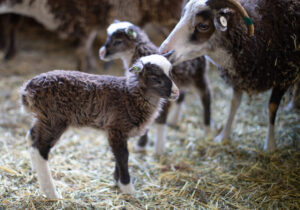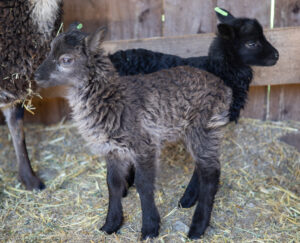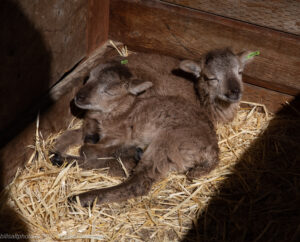How often do Soay ewes produce twins? Some thoughts and some data
For those of you interested in twinning rates, we have some data, but first a couple of comments and several caveats.We do not have any way to analyze the effect of nutrition on whether a ewe has twins. The commercial breeders use a system called “flushing” to get their ewes to twin. It involves ramping up the ewes’ nutrition (better quality hay, feed supplement, beet pulp) for the 30 days or so prior to the start of breeding and then ramping back down once breeding begins. The theory, as we understand it, is that the better nutrition fools the ewe into thinking times are good and she’ll drop two eggs. We tried flushing once or twice without dramatically different results.
Based on our experience, there is a significantly higher overall twinning rate if you do not breed your ewe lambs their first fall and instead give them a year to mature before putting them through the stress of pregnancy. Our AI ewes, the ones whose fathers lived in the U.K., twinned the first time we bred them (after maturing for a year) at a much higher rate (30% of all ewes who twinned the first time) even though these 10 ewes are only 6% of the total cohort of 169 ewes for whom we have twinning data. We assume this is due to their status as dramatically more genetically diverse than the vast majority of RBST Soay in North America, all of whom descend from just 4 ewes and 2 rams.
We can tell you how many of the ewe lambs born on our farm went on to twin at least once based on our records, what our customers have reported to us, and what we can find in the RBST database. For a lot of the Saltmarsh ewes bred on other farms, we do not have the data to be able to say whether ewes who twin once are likely to twin again or how often they twinned. Of the ewes who we have kept and bred, some are pretty consistent twinners, some have twinned only once or twice, and some have never twinned. But enough of our ewe lambs have gone to other farms that we cannot say with any certainty what portion of ewes who twin once will continue to twin and will consistently twin.
We also cannot provide the twinning rate for all RBST ewes in North America for the simple reason that some breeders do not birth notify or register a twin that dies at birth or within a day or two, and some breeders do not birth notify or register their ram lambs unless the owner plans to sell or use them as breeders. Any statement about the overall rate of twinning would undercount by an unknown amount.All of that said, we have had 283 RBST ewes born here over the last 15 years and we have lambing data for 169 of them through 2020, both births on our farm and births on our customers’ farms. We have no reason to think that the rate of twinning overall, and the impact on twinning of breeding ewe lambs before they mature, would alter these twinning rates.
If you’re ready to exercise your inner numbers geek, let’s look at the data.
Of the 169 Saltmarsh-born ewes, 33 were first bred when they were 6-8 months old, mostly on other farms but a few here in our first year of breeding.
1 of the 33 (3%) twinned her first year.
15 of them (45%) have twinned at least once so far
The bulk of the ewes, 136 in all, were not bred until they were a year and a half old
27 of them (20%) twinned their first breeding year
75 (55%) of them have twinned at least once so far
Overall, 90 (53%) of the 169 ewes have twinned at least once so far. For us, that means our 50% estimate of how many twins we will get each year is accurate enough for us.
At least 36, and probably a lot more, of the 169 have twinned more than once, since we assume some of their owners quit registering lambs at some point. We know of at least 7 ewes born here who went on to twin at least 3 times and 6 of them who twinned at least 4 times. Our twinning all-stars are 2008 ewe Ossie, who twinned 6 times even though she sat out 5 lambing years because we simply had too many ewes to breed all of them and she had already produced several daughters. She twinned again last year and just yesterday had her first single ever. Oh yes, the leader of the pack is Emily, a 2009 ewe who as of last week had twinned for us 7 times even though she also sat out a couple of years in the middle. She only singled once in all those years. So in answer to the question, do ewes keep twinning once they start? Some do, and how!
If there is data about twinning you would like to have us try to parse out for you in additional ways, please let us know. Otherwise, enjoy the photos of our 2001 twins so far, courtesy of friend and photographer extraordinaire Bill Saltzstein. The story of the orphans and how we “fostered” them is for another day. They are now 8 days old, robust, and feisty as can be.For now …


